By Fred Bass
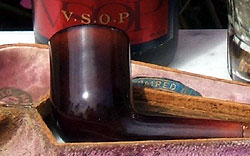 Whenever the discussion starts on Meerschaum Pipes, the most frequent topic for the last 300 years has been about the development of patina. A well seasoned Meerschaum Figural and the more conservative Plain shapes have long been regarded as desirable in the Pipe smoking community, so much so that people will go to great lengths to own them. Likely, it is the single most popular reason that many Pipe smokers become ardent devotees to the White Goddess, in search of the bloom of color that these Pipes display after years of smoking. The guy at the Pipe & Cigar shop, who sold you the object of your desire – a beautiful white Meerschaum in it’s form fitting case, that you’d been attracted to every time that you saw it, said that it would color nicely. What he didn’t tell you is that it can take a couple of lifetimes to fully color a Meerschaum. You’ve been smoking the Pipe for a few months and have only a slight blush of color starting on the plateau of the bowl, while beginning to wonder how many pounds of tobacco needs to be burnt in order to produce the patina you seek. This is where the search begins for the Proper Way to Color a Meerschaum, which is absolutely the most debated issue in both theory and technique in the Pipe smoking community, and will continue to be such after you and I have turned to dust.
Whenever the discussion starts on Meerschaum Pipes, the most frequent topic for the last 300 years has been about the development of patina. A well seasoned Meerschaum Figural and the more conservative Plain shapes have long been regarded as desirable in the Pipe smoking community, so much so that people will go to great lengths to own them. Likely, it is the single most popular reason that many Pipe smokers become ardent devotees to the White Goddess, in search of the bloom of color that these Pipes display after years of smoking. The guy at the Pipe & Cigar shop, who sold you the object of your desire – a beautiful white Meerschaum in it’s form fitting case, that you’d been attracted to every time that you saw it, said that it would color nicely. What he didn’t tell you is that it can take a couple of lifetimes to fully color a Meerschaum. You’ve been smoking the Pipe for a few months and have only a slight blush of color starting on the plateau of the bowl, while beginning to wonder how many pounds of tobacco needs to be burnt in order to produce the patina you seek. This is where the search begins for the Proper Way to Color a Meerschaum, which is absolutely the most debated issue in both theory and technique in the Pipe smoking community, and will continue to be such after you and I have turned to dust.
As with any topic in the world of Pipes, there are a host of answers to this quest, which start with the individual’s personal preference. The wealth of information available has no shortage of hearsay, fiction and myth about how best to go about getting that white Pipe to color. The frustration that many experience is just a part of the reason that these Pipes are held in high esteem when colored, which is a term that also holds a degree of ambiguity to many as to what this means. While some maintain that a color pattern of color starting in the shank and progressing up the bowl is best, others place high value on the uniformity of patina over the entire Pipe, while some maintain that the darker the coloration is best sought.
Theories abound on the dynamics of patina development. The common threads in all of them are the elements of fire, tobacco and Beeswax, since spermaceti is no longer legal to use in many countries. The needle like morphology of Sepiolite, which is a non-swelling clay that can absorb its weight in fluid, lends itself readily to the heat driven migration of Beeswax, thus providing pathways for the volatiles of the smoke to move in the Block. The Beeswax will be driven out of the Block by the heat generated by the smoking of the Pipe, leaving the volatiles that produce patina in the Block. This migration is dynamic, which means that coloration can come and go with time and use of the Pipe.
 |
| Spermaceti in both liquid and crystalline form. |
The continued use of Beeswax will both serve to protect the surface of the Pipe and aid in the migration of the volatiles that produce the patina. Generally, this starts in the Pipe’s shank, where the moisture of the cooling smoke collects, and progresses to the base of the bowl and then upward. I say generally because coloration of each Pipe is unique, being subject to quality and grain of the Block, the smoking habits of the individual, what blends are smoked and the presence of Beeswax. The range of color can display from flamingo pink to deeper red hues, amber to deeper browns and eventually to deep blues and black. Patina has been reported to disappear in the presence of steam and turn to a mottled grey in subzero temperatures. Color can fade and reappear with continued smoking of the Pipe. If you consider that the migration of patina is not just the display on the surface of the Pipe but a dynamic within the mass of the Block, then it’s easier to understand the migration of the volatiles that produce patina as moving in every direction, not just one. An example of this migration occurred in a Pipe that I purchased after it had been on display for a long time in a local shop. The side that was exposed to the air had absorbed smoke from the air, while the other side had not done so, as it was the side that was in contact with the open case. After smoking and waxing the Pipe for the first few smokes, the color had migrated to the Pipe’s shank and the patina became symmetric. The time required to develop dark coloration is what frustrates many and has motivated a search for ways to speed things up.
 |
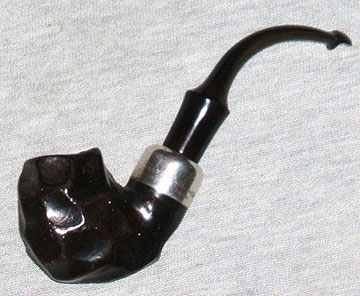 |
| Peterson African Block Facet 312 System with Aboriginal finish, which will also color with smoking. | Colored Peterson African Block Facet Meerschaum that has been smoked for many years. |
Carvers have a variety of finishes to employ in their craft. Beeswax can be used in white, yellow and burnt colors. Non-pigment Carver specific dark luster finishes are available, but no information is available as to how they are done and each is different, since information sharing in the Meerschaum world is unlikely. These finishes will color with smoking and waxing of the Pipe, just as the white wax finish does. Pigment finishes, which include the use of oxblood to most any color imaginable, do not generally develop patina with smoking the Pipe, but offers the appearance of coloration. African Block has frequently been finished with a wide range of color and patterns that often employ pigment. Dark Art finishes employ the use of fire and can involve wrapping the carved Block in wax soaked rags and setting fire to it or hanging the carved Block over a fire. This method is much the same effect in character as the result of using a smoke jar. These finishes will fade with smoking the Pipe and the use of Beeswax and color in areas of the Block where that have not been stained by this technique. Other methods have been employed that can be creative, from cooking the Block in a tobacco solution, painting the Block with tobacco juices or baking the Block in the presence of moist tobacco. For the most part, these are surface displays that do not look the same as the coloration that comes from smoking the Pipe, and are not resident with continues smoking and waxing of the Pipe. The coloration that comes from smoking the Pipe has no equal in depth and quality of display to those familiar with the differences.
The use of Beeswax can be accomplished by rubbing the Block with white Beeswax while the Pipe is being smoked, using the heat of the smoke to melt the wax and promote absorption into the Block. Excess that is not absorbed is buffed off with a white cotton rag. When the Pipe cools, if there are areas that feel rough on the Block’s surface, this means that the wax has migrated into the Block and you should rub more Beeswax on it and buff off the excess in order to protect the surface. Coloration that displays from this can be temporary, but thru continued smoking and use of Beeswax it will become resident. The result is most dramatic with Pipes that have been smoked for years that have never been waxed since the initial finish applied by the Carver. This is my preferred technique and it can be done as often as you wish, as the absorption by the Block is self limiting. I like it because it involves the least amount of materials and time to accomplish. Another method involves daubing melted Beeswax onto the Block and using a heat gun or hairdryer to melt off the excess, after the wax has cooled. This is effective but makes a mess and requires that all of the Pipes fittings be removed, as the heat will melt them.
First you melt the wax in a container and then daub some of it on the Pipe. I use a doubled up Pipe cleaner for this. Load the Pipe up with the wax so that it completely covers the Pipe. It’s best to do this over the pot of melted wax to catch the drippings. Once the wax has cooled, then use the hair dryer or heat gun to melt off the excess. I use a bit of cardboard inserted in the bowl’s chamber to hold the Pipe for this entire procedure. It’s a good idea to provide for the clean up by spreading out newspaper to catch the wax that comes off the Pipe during the process of melting off the excess. It’s important to mention that this should be done when the Pipe is dry, as moisture in the Block can cause it to crack during the heat application. The coloration produced will fade with smoking of the Pipe, but will become resident with repetition. Others have repeated the Carver’s immersion bath in liquid Beeswax, which may also include additives, which requires that the shank and bowl be corked to prevent the accumulation of Beeswax in the bowl and shank draft. This technique presents more hazard, as the Beeswax is flammable and should never be allowed to boil. It also requires that the Block must be closely watched for signs that it has absorbed its limit of wax. The Pipe is generally hand buffed before it cools to remove the excess, or you can employ the hairdryer as in the previously mentioned technique. Both of these latter methods require equipment and clean up.
Over the years, people have hired others to color their Meerschaums. This was done by Kings and the wealthy when both tobacco and Pipes were beyond the budget of the subjects. This practice continued and expanded to more as progress brought good fortune and luxury to more people. There’s even an article in the December 24, 1911 New York Times, in which such a Contractor laments: There used to be a time, sighed the Cigar store man, when I made a substantial addition to my income coloring Meerschaum Pipes for folk who were too lazy or ignorant of how to do it for themselves, but as in the case of many other industries manual labor, if you can call smoking manual labor, has had to give way before the march of machinery. He goes on to describe machines that can smoke a dozen Pipes at a time for as long as the machine operator fuels them. Of further interest he goes on to say; Do not handle the bowl or even touch it, especially when it is warm, as it will cause the bowl to become mottled and dirty. At the same time, do not cover it with chamois, which skin will absorb the wax and leave the bowl spotted.
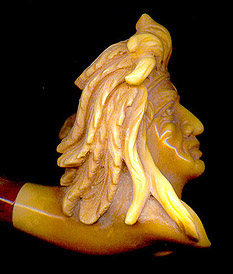 |
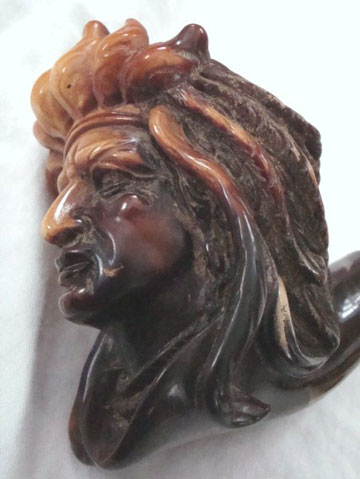 |
| Before & After Kadir Baysal’s Indian Chief, that has been smoked since ’06, after having been sold by Deniz Ural. |
|
This has been my experience as well, despite ample testament to the contrary. My Father tried the chamois technique to discover years later when he removed it that the Pipes had not colored. I’ve heard from a good number of people that after the Pipe has been smoked for 40-50 smokes that it’s OK to handle the Pipe, but this has not been my experience. I do not own a white glove, but handle the Pipe by the bit and use white cotton rags to both clean my Pipes and handle them during these cleanings. You must make your own choices in these matters. To me, it has always made sense that if the Block will absorb the Beeswax, it will also absorb whatever is on my hands. To others, this is not an important issue and they will handle the Pipe as they would a Briar. What keeps me interested in these Pipes is the level of flavor they deliver, when kept clean, as they do not flavor the smoke, after the Pipe has been broken it for the first few smokes to drive off the solvents and excess wax. If you get involved with these Pipes with the primary motivation to color them, then you will become a slave to the White Goddess and likely give up out of frustration because this is a lesson in delayed gratification.
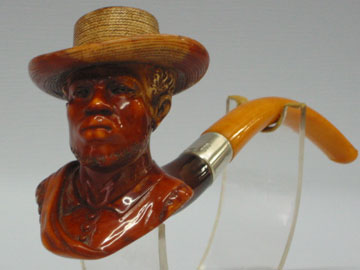 |
| Black Americana Pipe, made in 1889 Paris. |
Some other points worth mentioning start with the choice of tobacco.
Aromatics, Cavendish blends and other heavily cased tobacco will color a Meerschaum faster than the Virginia blends, English, Balkans and Orientals that I enjoy smoking. The use of a plug, made of clay, Meerschaum or tobacco, in the base of the bowl will collect the oils of smoking the Pipe and color it sooner. This involves smoking the tobacco load down to the level of the plug, which is to be left in the Pipe from 1-3 weeks. I prefer to clean my Pipes after every smoke, which benefits me with the clarity of smoke not otherwise encountered. This is also the reason that I keep the cake buildup to a minimum, so that I don’t need to dedicate a Pipe to a blend, with the exception of blends that will ghost any Pipe, such as St Bruno Flake, Condor and any blend with Deer Tongue in it. Others prefer to smoke their Pipes and rarely clean them, which again demonstrates that much of what you expect and seek from the smoking experience is the result of personal preference. It is also a good idea to smoke the Pipe slowly, for both better flavor, less trauma to your mouth and more complete patina development. The use of coloring bowls has been going on for centuries. Indeed, some of my Pipes have this old style construction where the coloring bowl is the only chamber to burn tobacco in. Coloring bowls are available and people that use them report good results in a more even patina development over the entire Block. They are Rube Goldberg affairs that are cumbersome but allow the Pipe to be exposed to the smoke while containing the heat, which results in longer residence of the Beeswax and even development of patina.
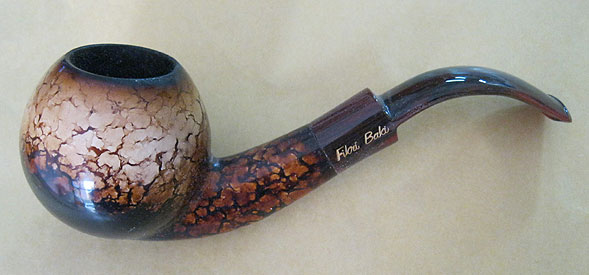 |
| Pipe carved by Fikri Baki, that has been smoked by him for a few months. It’s one of the most dramatic examples of marbled coloration I’ve seen. This patina development was accomplished by smoking the Pipe, which started out as the traditional white smooth finish. |
These are the basics and it’s your choice to employ them or not. What I’ve preferred over the years is to smoke the Pipes in my modest collection and wax them. The big incentive for me has been the clarity of the smoking experience. The display of patina is enjoyable, but not my focus. If you pursue the development of patina as your primary goal with these Pipes, then you become a Slave to the White Goddess, which doesn’t mean that you visit Helga’s House of Pain. My advice is to enjoy the smoke and be patient for the coloration display. You might be just a part of the legacy of a good Meerschaum, as it can take more time than most people live to fully color one of these Pipes.
Related Articles:
The Meerschaum Pipe Experience
The Thrill of the Hunt (A Guide to Estate Meerschaums)
|
Fred Bass is the founder of the "All Things Meerschaum Group" on Smoker’s Forums. You can see more of Fred’s Meerschaum Pipe Collection in his Pipe Photo Album, which includes close to 100 pipes. |



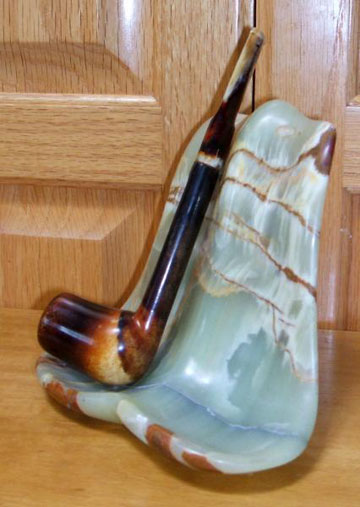
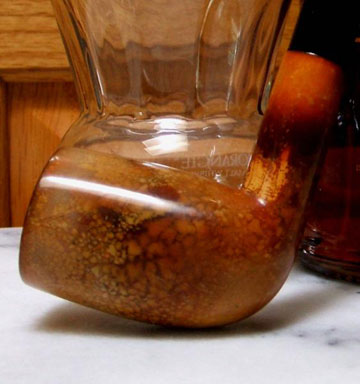

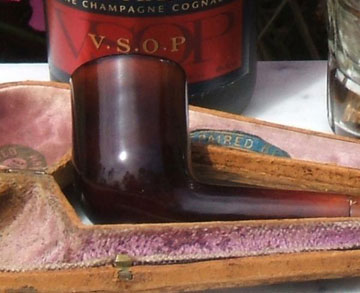
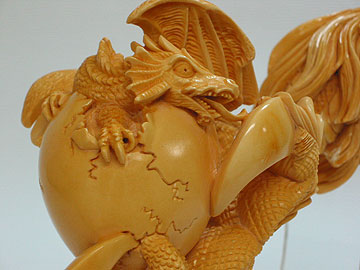
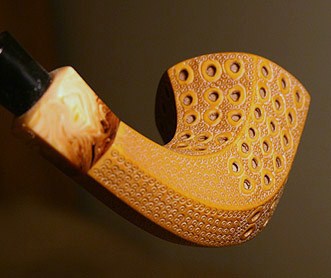



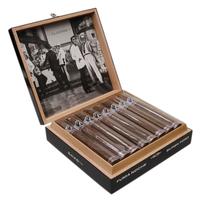






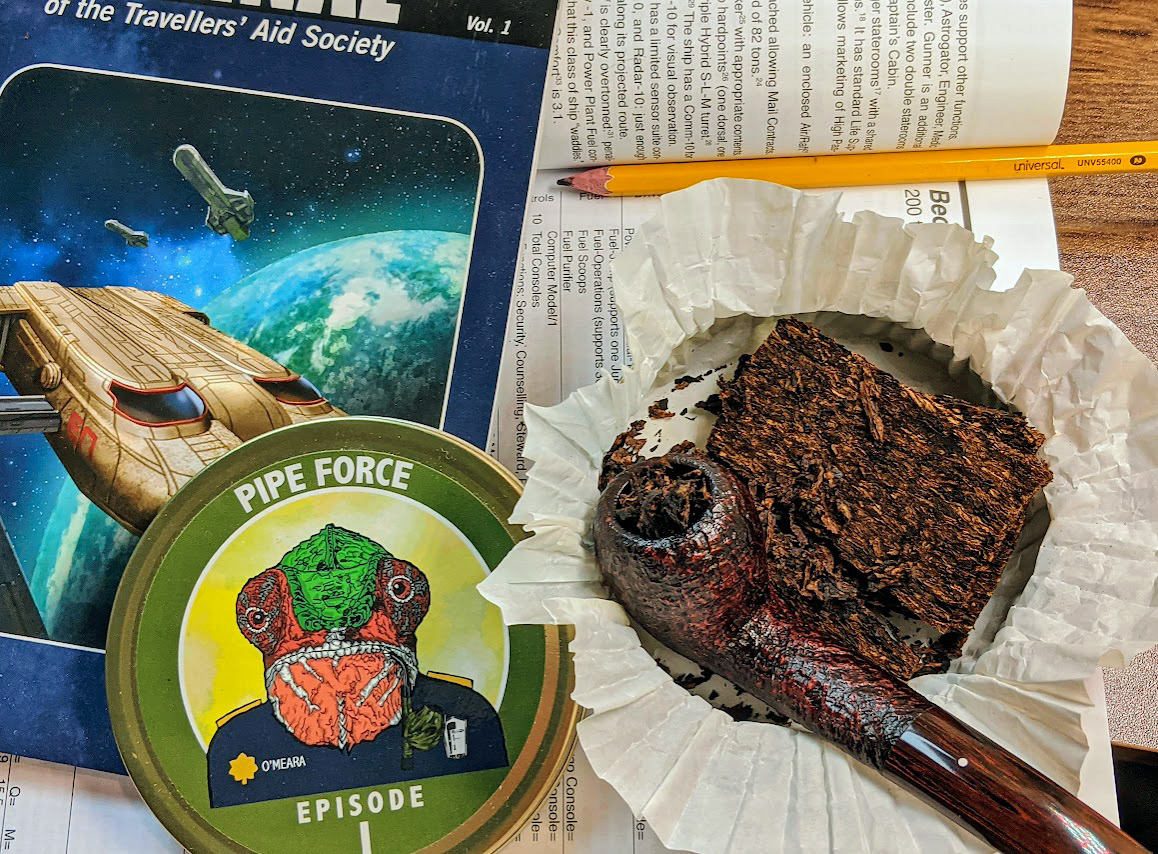




Excellent.
Well shoot, now I have to get a meer, soon. That lattice horn is one of the most beautiful pipes I have ever seen.
Another great article Fred. A lot of beautiful pipes as well.
Thanks for resolving a lot of issues concerning meer coloration. I found it particularly interesting that you have the patience and dexterity to hold the pipe by the stem. I tried that once, for about two bowls full, and decided that covering it with a chamois cloth was the way to go for me. I’ll be sure to leave a note in the pipe case that my great grandchild, after a lifetime of smoking the pipe, should remove the chamois and send a pic to PipesMagazine.
Enjoyed the article. It confirmed what I had heard & assumed that aromatics cause faster coloration. I have meers dedicated to all blends so I can see what the differences are. But as the article states it depends on Meer quality.
The quest continues….
Well done Fred!!
Funn
Thanks guys. These articles are fun to write and great to see that they
are read and enjoyed by others. They represent the collective efforts to
separate fact from myth within the membership of the All Things Meerschaum
Group. It’s Kevin’s journalism skills that really make them presentable
and eye candy.
Excellent article indeed!
Thanks for the contribution.
Many thanks Fred, I’m gonna try a Meerschaum now.
Andy
Great article and pictures. After years of trying to color my meerschaum pipes theres some light at the end of the tunnel.
Excellent,interesting, well illustrated piece Fred.
Nice article and good pics too. Yes, how many pounds does it take?? or was that TONS? I smoke my Meer because to me, hands down, it LOOKS better than any Briar pipe I’ve ever seen. Now, not saying that Briar is not Beautiful too, I have an affection for my wood, but you can’t CARVE a piece of Briar or any other wood, the way Meerschaum is Carved! If it colors, good. Dark Brown… not my color. It is BEAUTIFUL WHITE, with a FANTASTIC SHAPE… and TREMENDOUS carvings with Exacting Detail.. That’s why I bought the pipe! I am Happy just to LOOK at it! My only fear is that I break it somehow. That’s why it’s Good to have Wood too! Every man needs at least a few pipes, right? Many Ladies, but One above the Rest!
Even though I’m a fan of Briar, this was really an interesting read. I don’t think the Meerschaum path is for me, but I do enjoy the looks of a well seasoned example.
coloring of a meerschaum pipe mostly depends on flow of the smoke. not necessarily but in general coloring starts at shank due to smoke being trapped in that area most. so, if your primary aim is coloring then you should choose bowls which can trap some of the smoke in its chamber for longer period of time (such as apple, billiard, brandy etc) coloring is all about meer being a very porous material and beeswax actually have very small role in this process other than keeping everything in place, even and shiny.
to understand how/why the smoke coloring the meerschaum; hold a paper towel over tobacco smoke for a minute. same thing happens to your beard, moustache and fingers/nails for cigarette smokers.
here is an example of a smoke flow controlled meer coloring (smoked erinmore balkan, orlik golden sliced, davidoff cool mixture with this pipe, total 30 or 40 smokes in 6 months) http://img714.imageshack.us/img714/3364/luletasi.jpg
what’s the trick?
***spoiler***
as I mentioned above, it’s all about flow of the smoke. most of the smoke will flow away while you puff your pipe. if you could direct the smoke to pipe’s surface then with the help of the heat emitting from your pipe, meerschaum will absorb much more and much better. how you will do it? there are several ways but the most effective one –> smoke your pipe upside down for a couple puffs (if you can control your tobacco then smoke upside down from begining to end but I advice keeping an ashtray under it 🙂
see the picture for better explanation –> http://img574.imageshack.us/img574/940/lule.jpg
***spoiler end***
This is overall one of the better articles on meerschaum but you do not need to used bleached beeswax to have this kind of color. You can use unbleached beeswax mixed with any oil like olive oil which softens and makes it flow and put on wax all the time and it will color the same if you touch the pipe-wax it-clean with a Q-tip and water or saliva and lightly buff with soft cloth. I have been doing it for 48 years on hundreds of very old and new meerschaums. I have a new Youtube series that will be added to every month. Jason ‘The Meerschaum King’ Lang
What I’d like to know is how often or how do you know when to beeswax again?
I recently scored a lovely patent era K&P meerschaum.
The outside of the pipe was really filthy with what I believe now were seeping volatiles accumalated over years of the pipe not being smoked…it was more like crud than patina.
I super fine sandpapered that off and did beeswax immersion. Now that I’m smarter I’d clean with ethanol and not sand it though sanding was fine.
Colour returning nicely but unevenly.
just linked to this article for a chap who found a 90+ year old family heirloom. wonderful re-reading it, Fred!
Hello
About two years ago ,I bought a meerschaum pipe from Storient, an old exporter now selling pipes online http://www.storient.net as far as I have researched on the net.It has started to get darker in color as in the pictures above.All I want to learn is when it will be totally black just like the above pictures? Maybe 4-5 more years ?
And one more question to FRED BASS , is it possible to buy “unused” new but “black” colored meerschaum pipes ?
Kind Regards & Thanks
Adam Marsh